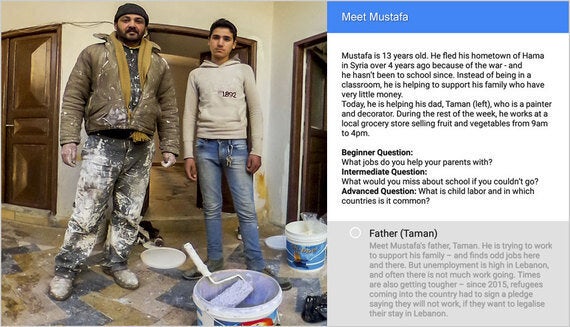Forget 360 action movies and hardcore gaming for just a moment, and ask yourself; if you were standing in somebody else's shoes, living their life virtually, how would that make you feel? That's the question posed by immersive journalism narratives such as 'Millions March' by VICE and 'Clouds Over Sidra' by Chris Milk and Gabo Arora, the latter of which was shown to leaders at the World Economic Forum. Milk has been vocal in the past about the potential of VR as an "empathy machine," and this sentiment is everywhere at the first ever VRUK Festival at Ravensbourne College in London.
In between stalls offering the coolest gaming demos are vastly different experiences like '6X9', a VR documentary created by The Mill and The Guardian, in which the viewer spends six minutes in solitary confinement in a US prison. Not only do spectators see first-hand what living conditions are like for prisoners, but they actually feel as if they have gone through the experience themselves, including the disorientation, hallucinations and other psychological strain that can occur when a person is deprived of human contact for an extended period of time.
Introducing "empathy goggles"
The notion of 'presence,' of forgetting your actual surroundings and fully buying into this first-person narrative, is at the centre of what makes VR such a powerful tool when it comes to raising awareness of serious issues. Far from being an isolationist medium, there are many who believe VR will help us connect with stories and with other people in a more profound way than has previously been possible.
Take, for example, the Department for International Development (DFID), which has collaborated with Google Expeditions on a series of virtual tours for UK Aid. These expeditions can transport a schoolchild in Britain to a Syrian refugee camp, where they have the opportunity to learn more about the stories of individual children who have been forced to leave their homes.
"We think that there's huge value in immersive experiences for our storytelling," says Marisol Grandon, Head of Creative Content at DFID. "It's a way to connect people with the aid that's happening on the ground, seeing other normal people like them... it takes away that barrier of seeing something through the lens of the media." It has become increasingly easy to consume and then forget traditionally packaged news reports, especially when they are discussing people in a faraway country, in their thousands or even in their millions. Scaling the crisis down to these individual stories means that viewers are more likely to make a connection that they will remember, in turn making the crisis more real and more important to them.

Grandon herself found that working on these Google Expeditions has helped her connect more personally with the subject matter: "One of the people who was filmed was a boy called Mustafa, who is thirteen, from Syria; he left because of the war four years ago. I've been working on this topic for a long time, so have all my colleagues, and it's really hard to continue connecting with people about something so big and so complex... For me, this boy, he left when he was nine, he's missed out on four years of education already. My son is eight, and seeing his progress through school as his mother, the idea that that would then be the end of his education and that he would then be working in a couple of years time -- it struck me in a way that other things haven't."
Empathetic impact aside, there are practical considerations to VR journalism that have yet to be fully addressed, according to Sarah Jones, founder of 360 Immersive Lab. Jones, who has a background in TV news, believes that we have yet to hit upon the right approach for immersive VR journalism, indeed if there even is one. Some viewers feel that their personal space is being invaded when a character is visually close to them, while others feel distracted by the constant voiceovers of reporter-led pieces, which they feel keep them from fully exploring the virtual setting. But with statistics from Greenlight VR suggesting that 71 per cent of Generation Z will own a VR headset, this is a news medium not to be ignored.
Just a few short years ago it was inconceivable that people would turn to Facebook for news, but now it is a primary source for many. VR will evolve in a similar way, says Jones, who predicts a significant portion of younger audiences embracing this distraction-free format. "It's not going to capture everybody, it's not going to be a tool for everybody," she says, "but it's a way of reaching those audiences that are pretty much switched off and disengaged from news. It's a way of helping them see the news in another way, and that, I think, is quite exciting."
Of course it's easy to say that VR holds the key to getting people to engage with tough subjects when it has yet to be adopted in the mainstream marketplace. "This thing is novel, it's new, and so maybe people will become inured to it eventually," says Grandon, "but for the moment, if someone has committed to have a look inside, they're likely to be quite struck by it."
The power of shared experience
"Empathy is bound up with imagination and all the other things that make us human," says Jane Gauntlett, an artist and producer whose 'In My Shoes' project was designed to give people an idea of what it is like to live with a brain injury. Gauntlett has created exhibitions in the past using various audio-visual techniques, but the advent of VR has enabled her to tell her story in a more intimate way; 'In My Shoes' is as close as you can get to literally being somebody else.
This experience allows viewers to grasp how it feels when their arms and legs don't respond to commands in the way that they should, and the feelings of fear and confusion that people go through during a seizure. 'In My Shoes' is now used in schools, universities and medical training to both educate and challenge preconceptions around brain damage. Gauntlett is also working on collaborative pieces which explore how it feels to suffer from OCD and hallucinations.
Gauntlett believes that placing somebody in a situation in the first person has more of an undeniable an impact than simply allowing them to witness it in the third person. "Empathy and shared experience can change the world," she says.
